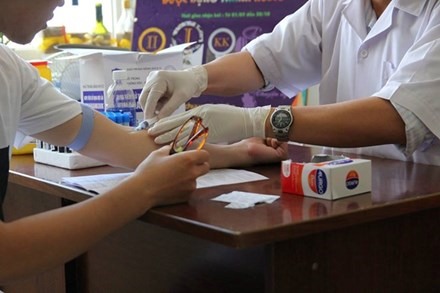 Society
Society

" />The head of the HCM City AIDS Prevention Centre has asked the Việt Nam Network of People Living with HIV/AIDS to help the country reach the 90-90-90 targets set by the Joint United Nations Programme on HIV and AIDS to help end the AIDS epidemic by 2030.
 |
| The head of the HCM City AIDS Prevention Centre has asked the Việt Nam Network of People Living with HIV/AIDS to help the country reach the 90-90-90 targets set by the Joint United Nations Programme on HIV and AIDS to help end the AIDS epidemic by 2030. — Photo laodong.com.vn |
HCM CITY — The head of the HCM City AIDS Prevention Centre has asked the Việt Nam Network of People Living with HIV/AIDS to help the country reach the 90-90-90 targets set by the Joint United Nations Programme on HIV and AIDS to help end the AIDS epidemic by 2030.
Speaking at a forum on MSM (men who have sex with men) and transgendered people about the UN targets on Monday, Tiêu Thị Thu Vân, said that Việt Nam was one of the first 30 countries to try to achieve the targets by 2020.
The 90-90-90 goals ensure that at least 90 per cent of all people with HIV will know their status, and that 90 per cent of people diagnosed with HIV will receive sustained antiretroviral (ARV) therapy. In addition, 90 per cent of all people receiving ARV therapy will be diagnosed with viral suppression.
HCM City was chosen as one of 32 cities worldwide to reach the targets by 2020, Vân said.
In the context of decreased international aid for HIV/AIDS prevention in the country, including in HCM City, the city is setting up a new treatment and management system to maintain positive results in prevention and achieve the targets.
The committee estimates that, according to the targets, the city will have 14,038 more people with HIV that need treatment by 2020.
Currently, the city’s hospitals and district’s preventive health centres are treating 27,500 people with HIV, she said.
Last year, the city had an estimated 41,841 people with HIV.
In the past, when international aid was provided, any patient with HIV who lived in the city, even those without an official residential book, was eligible to receive antiretroviral therapy.
However, the provision of therapy would no longer be the same when international aid was cut completely, Vân said, adding that it must be provided through health insurance.
Vân said the Việt Nam Network of People Living with HIV/AIDS(VNP+) could help patients with HIV in the network better understand the issue.
The network’s members can speak with health officials and encourage more people at a high risk of HIV to access testing services.
The network can also help its patients with HIV maintain treatment, as some of them give up treatment when they encounter obstacles.
Nguyễn Anh Phong, a representative of Việt Nam Network of People Living with HIV/AIDS in HCM City, said the network’s members would identify more patients with HIV and help them access ARV
The network only focused on prevention previously, Phong said.
A woman named Jessica, head of the JF Band, the name of a group which provides assistance to transgender people, said that she helps her members protect themselves from HIV infection.
A recent study showed that the city has around 30,000 MSM and transgender people, accounting for one per cent to three per cent of its male population.
They are at a high risk for HIV infection. It is estimated that the rate of HIV infection among MSM is nearly 16 per cent and 18 per cent for transgender people. —VNS




